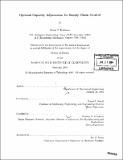| dc.contributor.advisor | . | en_US |
| dc.contributor.author | Budiman, Benny S., 1969- | en_US |
| dc.contributor.other | Massachusetts Institute of Technology. Dept. of Mechanical Engineering. | en_US |
| dc.date.accessioned | 2005-09-26T20:45:39Z | |
| dc.date.available | 2005-09-26T20:45:39Z | |
| dc.date.copyright | 2004 | en_US |
| dc.date.issued | 2004 | en_US |
| dc.identifier.uri | http://hdl.handle.net/1721.1/28495 | |
| dc.description | Thesis (Sc. D.)--Massachusetts Institute of Technology, Dept. of Mechanical Engineering, 2004. | en_US |
| dc.description | Includes bibliographical references (p. 117-124). | en_US |
| dc.description.abstract | This research attempts to answer the questions involving the time and size of capacity adjustments for better supply chain management. The objective of this research is to analytically determine simple structures to adjust capacity that require minimal computational resources and are relatively easy to implement. The research focuses on manufacturing companies that operate a make-to-order environment in which there is no inventory of finished products. The model used in the analysis is make to order with lost sales. The optimal capacity planning problem is formulated as a dynamic program that is solved analytically using Karush-Kuhn-Tucker conditions. The technique is used to derive optimal structures for three types of capacity planning: (a) making adjustment to aggregate capacity, (b) using overtime and making adjustment to the level of aggregate physical capacity, and (c) making adjustments to the levels of worker- and production-line-limited capacity. For aggregate capacity planning, the optimal structure is a capacity band whose lower and upper bounds depend on the probability distributions of demand and the cost parameters in a planning horizon. When attempting to plan capacity by simultaneously using overtime and making adjustment to physical capacity, it is optimal to either use overtime or adjust the level of aggregate capacity. The optimal structure for either using overtime or making adjustment to the level of physical capacity is also of the form of a capacity band. The optimal structures for optimal planning of the levels of worker- and production-line-limited capacity consist of two-dimensional capacity regions in which the levels of worker- and line-limited capacity are equal if reducing the levels of capacity yields nonnegative cost saving. This symmetry disappears | en_US |
| dc.description.abstract | (cont.) when reducing either level of capacity yields negative cost saving. | en_US |
| dc.description.statementofresponsibility | by Benny S. Budiman. | en_US |
| dc.format.extent | 124 p. | en_US |
| dc.format.extent | 5499222 bytes | |
| dc.format.extent | 5514466 bytes | |
| dc.format.mimetype | application/pdf | |
| dc.format.mimetype | application/pdf | |
| dc.language.iso | en_US | |
| dc.publisher | Massachusetts Institute of Technology | en_US |
| dc.rights | M.I.T. theses are protected by copyright. They may be viewed from this source for any purpose, but reproduction or distribution in any format is prohibited without written permission. See provided URL for inquiries about permission. | en_US |
| dc.rights.uri | http://dspace.mit.edu/handle/1721.1/7582 | |
| dc.subject | Mechanical Engineering. | en_US |
| dc.title | Optimal capacity adjustment for supply chain control | en_US |
| dc.type | Thesis | en_US |
| dc.description.degree | Sc.D. | en_US |
| dc.contributor.department | Massachusetts Institute of Technology. Department of Mechanical Engineering | |
| dc.identifier.oclc | 57306253 | en_US |
